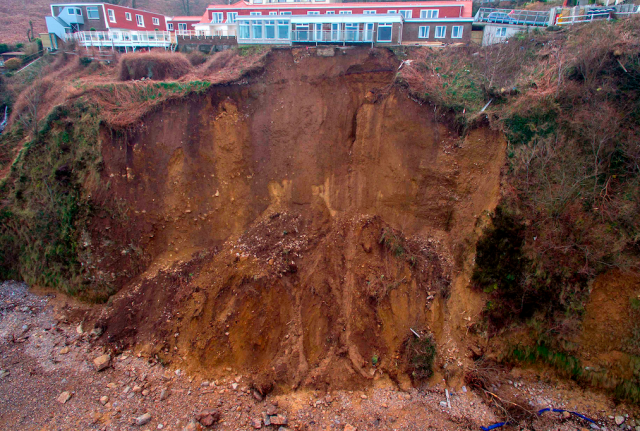15 March 2016
Bonne Nuit, Jersey: a strange place to build a new Care Home?
Posted by Dave Petley
Bonne Nuit rockfall
There is a somewhat amazing story being covered on various media outlets at the moment about a cliff collapse at Bonne Nuit on the island of Jersey. The news reports suggest that a brand new Care Home, the Cheval Roc Nursing and Residential Home, opened on the top of a coastal cliff in February. This looks to be a most impressive place, with wonderful views. Unfortunately though, Jersey was affected by strong storms this weekend (just the most recent of a series of weather events that have affected northern Europe this winter) which appears to have triggered a significant cliff collapse event:

Bonne Nuit cliff collapse via Yahoo News
.
Inevitably the recriminations have begun, and one does wonder how a development was allowed on this site. The Jersey Evening Post is running a story about the planning process for this site (update – it turns out that this is another landslide in Jersey in the last few days):
Planning’s handling of the redevelopment of the former Hotel La Tour was criticised in the wake of the landslip by former Planning chief officer John Young, who was parish Deputy of the area from 2011 to 2014 and during which time he represented residents who were objecting to the development.
But the news story from the time did not focus on the coastal erosion problem:
Objectors had said that the development would dominate the area, result in a loss of privacy, and that the building works would result in a lot of disruption.
To me the morphology of the slopes at Bonne Nuit suggest that they are, and have been, quite active. I am not familiar with the geology of Jersey, but interestingly Wikipedia suggests that there is extensive loess and Head:
During the Quaternary Devensian glaciation, loess was deposited, blown in by wind from the west. The loess has formed thick deposits on the island interior and combined with periglacial frost shattered rock fragments sliding down the cliffs to form head which have themselves been eroded to form cliffs from 3 to 12 metres high. At Belcroute there is a more complex deposit of loess head on a raised beach deposit elevated at 8 metres, that sits on another loess deposit. Head occurs at the foot of cliffs along the north, north east and south west sides, and can also be found beneath wind blown sand at the bays of St. Ouen, St. Aubin, St. Clement and the Royal Bay of Grouville. The thickest parts of loess are five metres deep at St Clements and at La Hougue Bie on the eastern plateau
This is not a material that I would expect to be resistant to erosion. I wonder therefore why a new development was allowed so close to the cliff edge?


 Dave Petley is the Vice-Chancellor of the University of Hull in the United Kingdom. His blog provides commentary and analysis of landslide events occurring worldwide, including the landslides themselves, latest research, and conferences and meetings.
Dave Petley is the Vice-Chancellor of the University of Hull in the United Kingdom. His blog provides commentary and analysis of landslide events occurring worldwide, including the landslides themselves, latest research, and conferences and meetings.